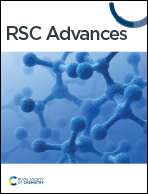Amidinoquinoxaline N-oxides: synthesis and activity against anaerobic bacteria†
Abstract
We present herein an in-depth study on the activity of amidinoquinoxaline N-oxides 1 against Gram-positive and Gram-negative anaerobic bacteria. Based on 5-phenyl-2,3-dihydropyrimidoquinoxaline N-oxide 1a, the selected structural variations included in our study comprise the substituents α− to the N-oxide function, the benzofused ring, substitution and quaternization of the amidine moiety, and the amidine ring size. Compounds 1 showed good to excellent antianaerobic activity, evaluated as the corresponding CIM50 and CIM90 values, and an antimicrobial spectrum similar to metronidazole. Six out of 13 compounds 1 had CIM90 values significantly lower than the reference drug. Among them, imidazoline derivatives 1i–l were the most active structures. Such compounds were synthesized by base-promoted ring closure of the corresponding amidines. The N-oxides under study showed no significant cytotoxicity against RAW 264.7 cells, with high selectivity indexes. Their calculated ADME properties indicate that the compounds are potentially good oral drug candidates. The antianaerobic activity correlated satisfactorily with the electron affinity of the compounds, suggesting that they may undergo bioreductive activation before exerting their antibacterial activity.



 Please wait while we load your content...
Please wait while we load your content...